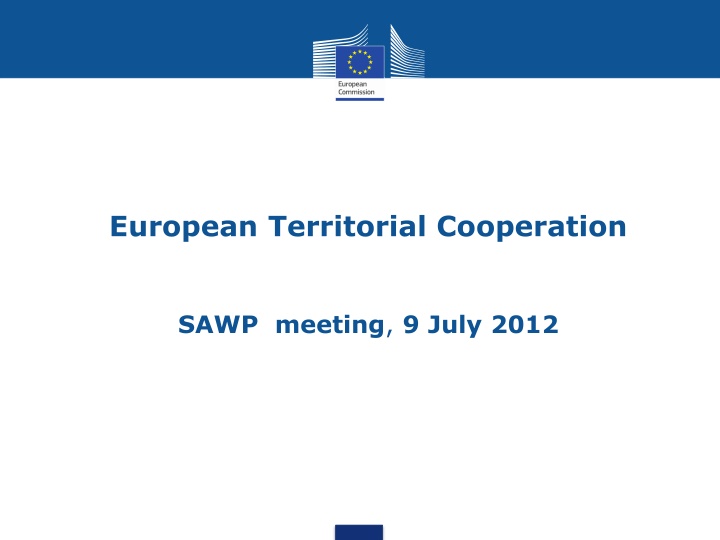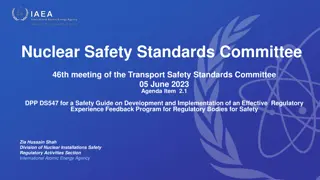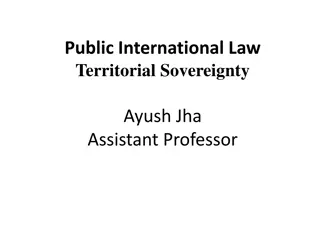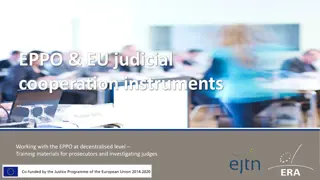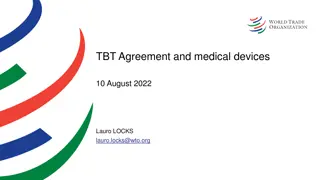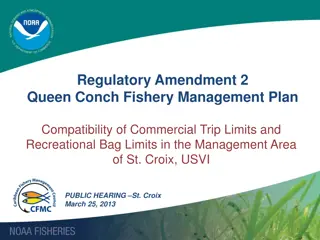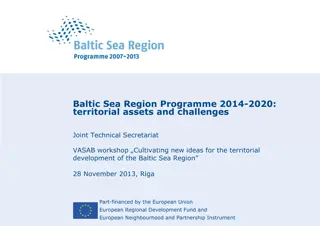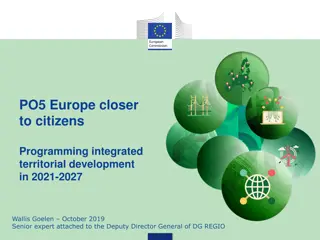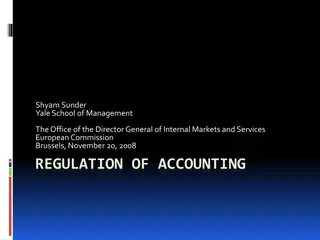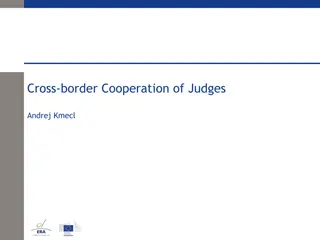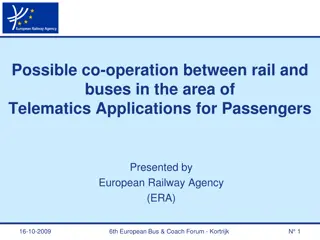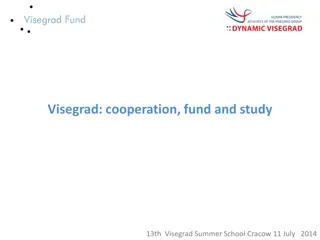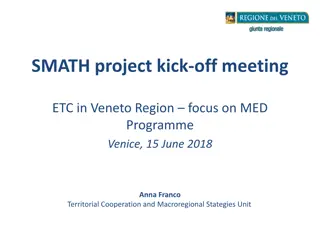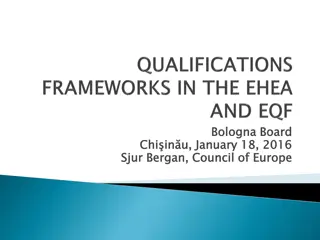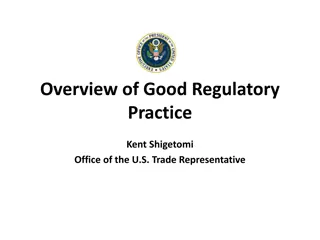European Territorial Cooperation: Regulatory Framework and Key Features
This content delves into the European Territorial Cooperation (ETC) regulatory framework, covering key regulations, the context of proposals, and the key features of ETC regulation. It discusses the scope of ETC regulation, components of the European territorial cooperation goal, and the relationship to other regulatory packages. The text also highlights the applicability of ETC in comparison to IPA/ENI funds and introduces new elements such as "INTERREG VC," "URBACT," and "INTERACT" to enhance cooperation initiatives.
Download Presentation

Please find below an Image/Link to download the presentation.
The content on the website is provided AS IS for your information and personal use only. It may not be sold, licensed, or shared on other websites without obtaining consent from the author.If you encounter any issues during the download, it is possible that the publisher has removed the file from their server.
You are allowed to download the files provided on this website for personal or commercial use, subject to the condition that they are used lawfully. All files are the property of their respective owners.
The content on the website is provided AS IS for your information and personal use only. It may not be sold, licensed, or shared on other websites without obtaining consent from the author.
E N D
Presentation Transcript
European Territorial Cooperation SAWP meeting, 9 July 2012 1
ETC in regulatory framework Four relevant regulations: - Common provisions for the ERDF, ESF, CF, EAFRD, EMFF - Fund-specific regulations for ERDF and ETC - EGTC regulation
ETC in context of proposals Overall reform aims apply (Europe 2020 alignment, thematic concentration, performance orientation) Cooperation activities of CSF Funds covered by Common Strategic Framework and Partnership contracts Performance framework applies, but not performance reserve Ex-ante conditionalities do not apply Changes deriving from revisions of Financial Regulation apply (annual accounts, designation mechanism etc.)
Key features of ETC regulation Continuity (three strands, joint programme management and project selection, lead partner principle etc.) Clarifications (responsibilities of bodies involved in programme implementation, third country involvement, role of EGTCs, Concept of sole beneficiary, use of the Euro) Strengthening of joint approach at programme and project level (eligibility rules, organisation of financial control and audit, project selection criteria)
Subject matter and scope Art. 1 ETC Regulation Scope of ERDF with regard to European territorial cooperation goal Relationship to other parts of regulatory package: CPR and chapter I of ERDF-regulation apply, except as specifically provided under the ETC- regulation or where provisions can only apply to Investment for Growth and Jobs goal Applicability ETC vs IPA/ENI: If ERDF is transferred to IPA/ENI, those rules apply If ENI/IPA Funds are transferred to ETC programmes, Art. 28 applies 5
Components of the European territorial cooperation goal, Art. 2 ETC-regulation Cross-border, transnational and interregional are kept New elements: Future "INTERREG VC": Link to Investment for Growth and Jobs programmes is made more explicit (Regions for Economic Change), can support all thematic objectives Future "URBACT": Explicit reference to rural development (for urban-rural linkages); complementary to urban development platform Future "INTERACT": Wording broadened to include support for macro-regional strategy processes, explicit reference to use of EGTC 6
Geographical coverage, Art. 3 ETC-Regulation Discussions on design of future programme areas are ongoing between Commission and Member States/regions No radical changes expected, rather adjustments for example to reflect regional strategies geography of macro- 7
Geographical coverage - cross-border cooperation, Art. 3 ETC-Regulation Cross-border cooperation COM to adopt list of cbc areas to receive support, broken down by cooperation programme (at NUTS 3 level) by implementing act List can include NUTS 3 regions on the border and adjacent areas (e.g. if included as flexibility area in 2007-2013), but no obligation List specifies NUTS level 3 regions taken into account for ERDF allocation on all internal and those external borders covered by IPA/ENI List includes regions in NO, CH etc. and countries neighbouring outermost regions for information purposes Addition of adjacent NUTS 3 regions may be proposed when submitting programmes ("safety net") 8
Geographical coverage transnational and interregional cooperation Transnational cooperation COM to adopt list of transnational areas to receive support by programme (at NUTS 2 level), as in 2007-2013 Third country regions covered by ENI (incl. Russia) and IPA can also be covered by programme, funding from external instruments to be made available Third country regions included in list for information purposes Addition of adjacent NUTS 2 regions may be proposed when submitting programmes ("safety net") Interregional cooperation EU-28, whole or part of territory of third countries may be covered 9
Resources for European Territorial Cooperation Art. 4 ETC-Regulation Allocation mechanism remains as in 2007-2013 (by MS for cbc and transnational, by programme for interregional) New: Outermost regions: guaranteed increase of 150 % of ERDF support received in 2007-2013, additional EUR 50 mio.set aside from interregional envelope Amount to be transferred to ENI/IPA to be established by COM and MS If no programme submitted, funds to be allocated to internal cbc programmes of Member State concerned 10
Selection of operations Art. 11 ETC-regulation Monitoring Committee selects operations No changes in requirements for number of beneficiaries in operation Beneficiaries to cooperate in development, implementation, staffing and financing of operations Operation may be implemented in a single country if for the benefit of the programme area (e.g. joint research center) Concept of sole beneficiary (if multi-national character) MA to provide lead beneficiary with document setting out conditions of support, including products and services to be delivered and time-limit for execution (like "grant offer letter", "subsidy contract" now) 11
Beneficiaries, Art. 12 ETC-Regulation Responsibility of lead partner remains as in 2007-2013 Changes reflect concept of sole beneficiary (para. 1) possibility to carry out management verifications by Managing authority (2d) and ensure coherence with CPR (para.3) Art. 20(2) of current ERDF regulation is taken out, because covered in Art. 25 (3) (recoveries) and Art. 19 (2c) (eligibility of operations depending on location) 12
Implementation reports and annual review, Art. 13, 14 ETC-regulation Need to be aligned with CPR Additional possibility to carry out annual review in writing (reflects current practice), but annual meeting remains possible 13
Participation of third countries Art. 28 ETC-Regulation IPA transnational/interregional programmes for participation of third countries (as now for South East Europe and MED programmes, but no explicit provision in regulation) and/or ENI funds can be transferred to Rules on financial management, programming, monitoring, evaluation and control for financial participation of third countries in transnational and interregional programmes to be established in cooperation programme or financing agreement Should facilitate use of the funding in accordance with ETC rules, but will depend on final versions of IPA, ENI, FR and MFF 14
ETC Thank you for your attention! 15
